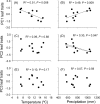Interspecific variation in leaf functional and defensive traits in oak species and its underlying climatic drivers
- PMID: 30125315
- PMCID: PMC6101385
- DOI: 10.1371/journal.pone.0202548
Interspecific variation in leaf functional and defensive traits in oak species and its underlying climatic drivers
Abstract
Plants exhibit a diverse set of functional traits and ecological strategies which reflect an adaptation process to the biotic and abiotic components of the environment. The Plant Economic Spectrum organizes these traits along a continuum from conservative to acquisitive resource use strategies and shows how the abiotic environment governs a species' position along the continuum. However, this framework does not typically account for leaf traits associated with herbivore resistance, despite fundamental metabolic links (and therefore co-variance) between resource use traits and defensive traits. Here we analyzed a suite of leaf traits associated with either resource use (specific leaf area [SLA], nutrients and water content) or defenses (phenolic compounds) for saplings of 11 species of oaks (Quercus spp.), and further investigated whether climatic variables underlie patterns of trait interspecific variation. An ordination of leaf traits revealed the primary axis of trait variation to be leaf economic spectrum traits associated with resource use (SLA, nitrogen, water content) in conjunction with a defensive trait (condensed tannins). Secondary and tertiary axes of trait variation were mainly associated with other defensive traits (lignins, flavonoids, and hydrolysable tannins). Within the primary axis we found a trade-off between resource use traits and both water content and condensed tannins; species with high SLA and leaf N values invested less in condensed tannins and viceversa. Moreover, temperature and precipitation mediated the trait space occupied by species, such that species distributed in warmer and drier climates had less leaf N, lower SLA, and more defenses (condensed tannins, lignins and flavonoids), whereas opposite values were observed for species distributed in colder and wetter climates. These results emphasize the role of abiotic controls over all-inclusive axes of trait variation and contribute to a more complete understanding of interspecific variation in plant functional strategies.
Conflict of interest statement
The authors have declared that no competing interests exist.
Figures


Similar articles
-
Parallel increases in insect herbivory and defenses with increasing elevation for both saplings and adult trees of oak (Quercus) species.Am J Bot. 2019 Dec;106(12):1558-1565. doi: 10.1002/ajb2.1388. Epub 2019 Nov 13. Am J Bot. 2019. PMID: 31724166
-
Biotic and abiotic factors associated with altitudinal variation in plant traits and herbivory in a dominant oak species.Am J Bot. 2016 Dec;103(12):2070-2078. doi: 10.3732/ajb.1600310. Epub 2016 Dec 13. Am J Bot. 2016. PMID: 27965243
-
Inducibility of chemical defences in young oak trees is stronger in species with high elevational ranges.Tree Physiol. 2019 Apr 1;39(4):606-614. doi: 10.1093/treephys/tpy139. Tree Physiol. 2019. PMID: 30597091
-
An integrated framework of plant form and function: the belowground perspective.New Phytol. 2021 Oct;232(1):42-59. doi: 10.1111/nph.17590. Epub 2021 Jul 30. New Phytol. 2021. PMID: 34197626 Review.
-
Consequences of interspecific variation in defenses and herbivore host choice for the ecology and evolution of Inga, a speciose rainforest tree.Oecologia. 2018 Jun;187(2):361-376. doi: 10.1007/s00442-018-4080-z. Epub 2018 Feb 10. Oecologia. 2018. PMID: 29428967 Review.
Cited by
-
Variation in climatic tolerance, but not stomatal traits, partially explains Pooideae grass species distributions.Ann Bot. 2021 Jul 28;128(1):83-95. doi: 10.1093/aob/mcab046. Ann Bot. 2021. PMID: 33772589 Free PMC article.
-
Integrating defense and leaf economic spectrum traits in a tropical savanna plant.Front Plant Sci. 2023 Jun 5;14:1185616. doi: 10.3389/fpls.2023.1185616. eCollection 2023. Front Plant Sci. 2023. PMID: 37342149 Free PMC article.
-
Climate and the biotic community structure plant resistance across biogeographic groups of yellow monkeyflower.Ecol Evol. 2022 Nov 22;12(11):e9520. doi: 10.1002/ece3.9520. eCollection 2022 Nov. Ecol Evol. 2022. PMID: 36440318 Free PMC article.
-
Transcriptomic Analysis on the Peel of UV-B-Exposed Peach Fruit Reveals an Upregulation of Phenolic- and UVR8-Related Pathways.Plants (Basel). 2023 Apr 28;12(9):1818. doi: 10.3390/plants12091818. Plants (Basel). 2023. PMID: 37176875 Free PMC article.
-
A trait-based plant economic framework can help increase the value of reforestation for conservation.Ecol Evol. 2022 Apr 29;12(5):e8855. doi: 10.1002/ece3.8855. eCollection 2022 May. Ecol Evol. 2022. PMID: 35509611 Free PMC article.
References
-
- Westoby M, Falster DS, Moles AT, Vesk PA, Wright IJ. Plant ecological strategies: some leading dimensions of variation between species. Annu Rev Ecol Evol System. 2002;33:125–159.
-
- Ackerly DD, Schwilk DW, Webb CO. Niche evolution and adaptive radiation: testing the order of trait divergence. Ecology. 2006;87:S50–S61. - PubMed
Publication types
MeSH terms
Substances
LinkOut - more resources
Full Text Sources
Other Literature Sources
Miscellaneous

